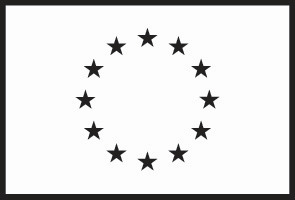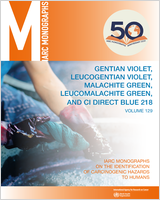NCBI Bookshelf. A service of the National Library of Medicine, National Institutes of Health.
This volume of the IARC Monographs provides evaluations of the carcinogenicity of three dyes and their two leucometabolites: gentian violet, leucogentian violet, malachite green, leucomalachite green, and CI Direct Blue 218.
Gentian violet and malachite green are cationic triphenylmethane dyes widely used for textiles, paper, and acrylic products, as biological stains, and in some hair dyes and other cosmetics. Because of their antibacterial and antifungal properties, they have had various medical, veterinary, and aquaculture applications, including the treatment of livestock, animal feed, ornamental fish, and farmed fish and shellfish.
Leucogentian violet and leucomalachite green are used as precursors in the production of their parent compounds and have direct applications as chromogenic reagents in analytical chemistry and as radiochromic indicators in dosimeters.
CI Direct Blue 218 is a copper-chelated dimethoxybenzidine-based azo dye used for cellulose, acetate, nylon, silk, wool, tissue, fine papers, and textile goods.
For all agents, data were sparse regarding exposure levels, but indicated that exposures can occur in occupational settings and in the general population.
An IARC Monographs Working Group reviewed evidence from cancer bioassays in experimental animals and mechanistic studies to assess the carcinogenic hazard to humans of exposure to these agents and concluded that:
Gentian violet, leucomalachite green, and CI Direct Blue 218 are possibly carcinogenic to humans (Group 2B)
Leucogentian violet and malachite green are not classifiable as to their carcinogenicity in humans (Group 3).
Contents
This publication represents the views and expert opinions of an IARC Working Group on the Identification of Carcinogenic Hazards to Humans, which met remotely, 22 February – 5 March 2021.
Lyon, France – 2022
Library Cataloguing Data
IARC Monographs
In 1969, the International Agency for Research on Cancer (IARC) initiated a programme on the evaluation of the carcinogenic hazard of chemicals to humans, involving the production of critically evaluated monographs on individual chemicals. The programme was subsequently expanded to include evaluations of carcinogenic hazards associated with exposures to complex mixtures, lifestyle factors and biological and physical agents, as well as those in specific occupations. The objective of the programme is to elaborate and publish in the form of monographs critical reviews of data on carcinogenicity for agents to which humans are known to be exposed and on specific exposure situations; to evaluate these data in terms of cancer hazard to humans with the help of international working groups of experts in carcinogenesis and related fields; and to identify gaps in evidence. The lists of IARC evaluations are regularly updated and are available on the internet at https://monographs.iarc.who.int/.
This programme has been supported since 1982 by Cooperative Agreement U01 CA33193 with the United States National Cancer Institute, Department of Health and Human Services. Additional support has been provided since 1986 by the European Commission Directorate-General for Employment, Social Affairs, and Inclusion, initially by the Unit of Health, Safety and Hygiene at Work, and since 2014 by the European Union Programme for Employment and Social Innovation "EaSI" (for further information please consult: https://ec.europa.eu/social/easi). Support has also been provided since 1992 by the United States National Institute of Environmental Health Sciences, Department of Health and Human Services. The contents of this volume are solely the responsibility of the Working Group and do not necessarily represent the official views of the United States National Cancer Institute, the United States National Institute of Environmental Health Sciences, the United States Department of Health and Human Services, or the European Commission.

- Published by the International Agency for Research on Cancer, 150 cours Albert Thomas, 69372 Lyon Cedex 08, France
- ©International Agency for Research on Cancer, 2022
- On-line publication, March 2022, updated December 2022
- Distributed by WHO Press, World Health Organization, 20 Avenue Appia, 1211 Geneva 27, Switzerland
- (tel.: +41 22 791 3264; fax: +41 22 791 4857; email: tni.ohw@sredrokoob).
- Publications of the World Health Organization enjoy copyright protection in accordance with the provisions of Protocol 2 of the Universal Copyright Convention. All rights reserved.
- Corrigenda to the IARC Monographs are published online at https://publications.iarc.fr
Corrigenda to Volume 129. (PDF, 96K)
- To report an error, please contact: rf.crai@omi
The International Agency for Research on Cancer welcomes requests for permission to reproduce or translate its publications, in part or in full. Requests for permission to reproduce or translate IARC publications – whether for sale or for non-commercial distribution – should be addressed to IARC Publications at: rf.crai@snoitacilbup.
The designations employed and the presentation of the material in this publication do not imply the expression of any opinion whatsoever on the part of the Secretariat of the World Health Organization concerning the legal status of any country, territory, city, or area or of its authorities, or concerning the delimitation of its frontiers or boundaries.
The mention of specific companies or of certain manufacturers’ products does not imply that they are endorsed or recommended by the World Health Organization in preference to others of a similar nature that are not mentioned. Errors and omissions excepted, the names of proprietary products are distinguished by initial capital letters.
The IARC Monographs Working Group alone is responsible for the views expressed in this publication.
IARC Library Cataloguing-in-Publication Data
Names: IARC Working Group on the Identification of Carcinogenic Hazards to Humans.
Title: Gentian violet, leucogentian violet, malachite green, leucomalachite green, and CI Direct Blue 218.
Description: Lyon: International Agency for Research on Cancer, 2022. | Series: IARC monographs on the identification of carcinogenic hazards to humans, ISSN 1017-1606; v. 129. | “This publication represents the views and expert opinions of an IARC Working Group on the Identification of Carcinogenic Hazards to Humans, which met remotely, 22 February – 5 March 2021.” | Includes bibliographical references. | Spine title: Some dyes and their leucometabolites.
Identifiers: ISBN 9789283201694 (pbk.) | ISBN 9789283201960 (ebook)
Subjects: MESH: Carcinogens. | Neoplasms--chemically induced. | Gentian Violet --adverse effects. | Rosaniline Dyes--adverse effects. | Risk Factors.
Classification: NLM W1
About the cover: Gentian violet, malachite green, and CI Direct Blue 218 are widely used as textile dyes.
Source: © Adobe Stock/Pornthiwa
How to cite: IARC (2022). Gentian violet, leucogentian violet, malachite green, leucomalachite green, and CI Direct Blue 218. IARC Monogr Identif Carcinog Hazards Hum, 129:1–178.
- Magnetic solid-phase extraction for determination of the total malachite green, gentian violet and leucomalachite green, leucogentian violet in aquaculture water by high-performance liquid chromatography with fluorescence detection.[J Sep Sci. 2016]Magnetic solid-phase extraction for determination of the total malachite green, gentian violet and leucomalachite green, leucogentian violet in aquaculture water by high-performance liquid chromatography with fluorescence detection.Zhao J, Wei D, Yang Y. J Sep Sci. 2016 Jun; 39(12):2347-55. Epub 2016 May 31.
- Carcinogenicity of gentian violet, leucogentian violet, malachite green, leucomalachite green, and CI Direct Blue 218.[Lancet Oncol. 2021]Carcinogenicity of gentian violet, leucogentian violet, malachite green, leucomalachite green, and CI Direct Blue 218.IARC Monographs Vol 129 group. Lancet Oncol. 2021 May; 22(5):585-586. Epub 2021 Mar 25.
- Particle beam liquid chromatography-mass spectrometry of triphenylmethane dyes: application to confirmation of malachite green in incurred catfish tissue.[J Chromatogr B Biomed Appl. 1995]Particle beam liquid chromatography-mass spectrometry of triphenylmethane dyes: application to confirmation of malachite green in incurred catfish tissue.Turnipseed SB, Roybal JE, Rupp HS, Hurlbut JA, Long AR. J Chromatogr B Biomed Appl. 1995 Aug 4; 670(1):55-62.
- Review Some Aromatic Amines and related Compounds[ 2021]Review Some Aromatic Amines and related CompoundsIARC Working Group on the Identification of Carcinogenic Hazards to Humans. 2021
- Review Some nitrobenzenes and other industrial chemicals[ 2020]Review Some nitrobenzenes and other industrial chemicalsIARC Working Group on the Evaluation of Carcinogenic Risks to Humans. 2020
- Gentian Violet, Leucogentian Violet, Malachite Green, Leucomalachite Green, and ...Gentian Violet, Leucogentian Violet, Malachite Green, Leucomalachite Green, and CI Direct Blue 218
- Rattus norvegicus kinesin light chain KLCt mRNA, complete cdsRattus norvegicus kinesin light chain KLCt mRNA, complete cdsgi|10281105|gb|AF166267.1|Nucleotide
- PC02G07 Pine TriplEx pollen cone library Pinus taeda cDNA clone PC02G07, mRNA se...PC02G07 Pine TriplEx pollen cone library Pinus taeda cDNA clone PC02G07, mRNA sequencegi|7134584|gnl|dbEST|3922533|gb|AW4 .1|Nucleotide
Your browsing activity is empty.
Activity recording is turned off.
See more...

